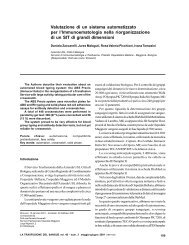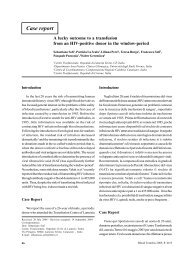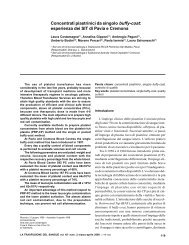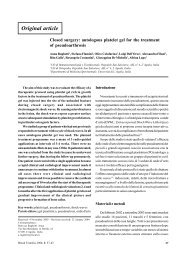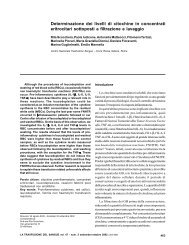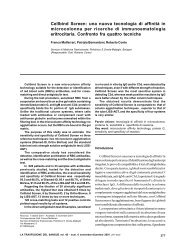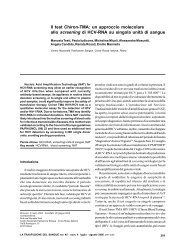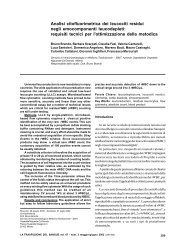Mitogen-stimulated DAT: a new method for the ... - Blood Transfusion
Mitogen-stimulated DAT: a new method for the ... - Blood Transfusion
Mitogen-stimulated DAT: a new method for the ... - Blood Transfusion
You also want an ePaper? Increase the reach of your titles
YUMPU automatically turns print PDFs into web optimized ePapers that Google loves.
W Barcellini et al.MS-<strong>DAT</strong> in <strong>the</strong> clinical follow up of AIHAMS-<strong>DAT</strong> was per<strong>for</strong>med in 6 AIHA regularlyfollowed at <strong>the</strong> out-patient department. The test wasper<strong>for</strong>med at each medical examination, toge<strong>the</strong>r withblood counts and haemolytic parameters. Two typicalcases are shown in Figure 1.The first case (left panel) was a 70 years old manwith an acute onset of typical warm AIHA,subsequently treated with steroid. The <strong>the</strong>rapyinduced a progressive increase of haemoglobin levels(from 5.8 to 15.3 g/dL in 7 months), normalisation of<strong>the</strong> haptoglobin levels (from 200 to 1,370 mg/L),toge<strong>the</strong>r with a decrease of MS-<strong>DAT</strong> values (from 4,121to 374 IgG ng/mL).The second case (right panel) was a 50 years oldwoman with AIHA in clinical remission (Hb 13.6 g/dL)on low-dose steroid <strong>the</strong>rapy. During <strong>the</strong> follow-up ahaemolytic relapse occurred, with decrease ofhaemoglobin (from 13.6 to 10 g/dL) and haptoglobin(from 590 to 200 mg/L) levels. Interestingly, MS-<strong>DAT</strong>showed an increased positivity which preceded <strong>the</strong>clinical worsening (from 41 to 176 IgG ng/mL) and wasclearly positive at <strong>the</strong> time of overt anaemia (355 and528 IgG ng/mL).The mild haemolytic relapse was promptly controlledby steroid <strong>the</strong>rapy which induced a normalisation ofhaemoglobin (from 10 to 13.4 g/dL) and haptoglobin(from 200 to 430 mg/L) levels and a decrease of MS-<strong>DAT</strong> values (from 528 to 166 IgG ng/mL).DiscussionResults presented in this paper showed that MS-<strong>DAT</strong> was positive in <strong>DAT</strong>-negative patients with ahistory of AIHA, who were in clinical and laboratoryremission and, more interestingly, in patientstentatively diagnosed as <strong>DAT</strong>-negative AIHA on <strong>the</strong>basis of exclusion of o<strong>the</strong>r causes of haemolysis andof <strong>the</strong> clinical response to steroid <strong>the</strong>rapy. Moreover,MS-<strong>DAT</strong> was positive in 1/3 of <strong>DAT</strong>-negative B-CLLpatients without haemolytic features, confirmingprevious findings 19 .Absolute values of IgG bound to RBC are greaterin mitogen-<strong>stimulated</strong> cultures, as compared toun<strong>stimulated</strong> ones, both in AIHA and in B-CLLpatients 17,19 .On <strong>the</strong> contrary, mitogen stimulation has no effectadese alle emazie sono maggiori nelle colture di sangue interostimolate con mitogeni se paragonati a quelli rilevabili incolture non stimolate, sia nei pazienti affetti da MEA che inquelli affetti da B-LLC 17,19 . Al contrario, la stimolazione conmitogeni non ha alcun effetto nei controlli, dove non visono linfociti B potenzialmente autoreattivi, così da esserestimolati in vitro a produrre anticorpi antieritrocitari. Nelloro insieme, questi risultati indicano che la stimolazionecon mitogeni sembra essere in grado di svelareun'autoimmunità antieritrocitaria latente, sia nella MEA inremissione clinica che nella B-LLC. Questo dato potrebbeessere utile per continuare il monitoraggio clinico elaboratoristico dei pazienti con MEA in remissione e perprogrammare un follow-up più intensivo nei pazienti B-LLC,soprattutto in quelli in trattamento con fludarabina 23-26 .Tuttavia, per accertare il valore predittivo del test, si rendenecessario un controllo clinico a distanza di tempo deipazienti affetti da B-LLC con MS-<strong>DAT</strong> positivo. Abbiamo,inoltre, individuato 7 pazienti con diagnosi di MEA TADnegativa,presuntivamente posta sulla base dell'esclusionedi altre cause di emolisi: tale diagnosi è stata confermatadalla positività di MS-<strong>DAT</strong>. È noto che tutti i metodi adisposizione per la diagnosi di MEA possono dare risultatifalsamente negativi e che è necessario disporre di una batteriadi test, piuttosto che di un singolo tipo di esame 2,10,16 . Diconseguenza, MS-<strong>DAT</strong> potrebbe essere proposto come testsupplementare per la diagnosi di MEA. La negatività delTAD eseguito con metodiche standard è spesso dovuta adnumero esiguo di molecole immunoglobuliniche presentisulla superficie eritrocitaria 8 . Così come si osserva nella MEAin remissione e nella B-LLC, la stimolazione con mitogenipuò provocare, anche nelle <strong>for</strong>me di MEA TAD-negative, laproduzione in vitro di anticorpi e la loro conseguenteadesione alle emazie autologhe presenti nella coltura,determinando la positività del TAD. Infine, MS-<strong>DAT</strong> è statoeseguito routinariamente nel corso dei follow-up di pazientiaffetti da MEA e i valori ottenuti sono risultati correlarecon il decorso clinico, con i parametri emolitici e con larisposta alla terapia. Un dato di particolare interesse è cheMS-<strong>DAT</strong> ha rivelato una aumentata positività cheprecedeva il peggioramento clinico, indicando, una voltadi più, che la stimolazione con mitogeni è in grado di svelareuna autoimmunità latente e agire da "cassa di risonanza"per l'individuazione di una risposta autoimmunitaria.ConclusioniIl test che abbiamo descritto in questo lavoro sembra ingrado di evidenziare un'autoimmunità antieritrocitaria latente,sia in MEA in fase di remissione clinica sia in corso di B-LLC.134<strong>Blood</strong> Transf 2003; 2: 127-36



